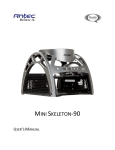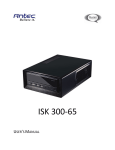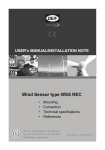Download Antec NSK 4482
Transcript
NSK 4482 / NSK 4482B User’s Manual Table of Contents Introduction 1.1 Case Specifications………………...……………......………….....… 2 1.2 Diagram……………………………………………....…......…….....… 2 Hardware Installation Guide 2.1 Setting Up……….…......…................................….................. 2.2 Motherboard Installation……………………………….......….....…. 2.3 3.5” Device Installation…………………………….….........…........ 2.4 5.25” Device Installation……………….…….....…...................... 3 3 3 4 Connecting the Front I/O Ports 3.1 USB 2.0 Ports……………………………...……........……….....…… 3.2 AC’97 / HD Audio Ports......……………….................………...... 3.3 Switch and LED Connectors…………………………..…..…….....… 3.4 Rewiring Motherboard Header Connectors.........……….......…… 4 5 5 6 Cooling System 4.1 Rear Exhaust TriCool™ Fan.…….........……...…........................ 6 4.2 Front 80mm Intake Fan……………….....…………...........…....... 7 4.3 Thermally Advantaged Chassis (TAC 2.0)……......……….......... 7 At Antec, we continually refine and improve our products to ensure the highest quality. It’s possible that your new case will differ slightly from the descriptions in this manual. This isn’t a problem; it’s simply an improvement. As of the date of publication, all features, descriptions, and illustrations in this manual are correct. Disclaimer This manual is intended only as a guide for Antec’s Computer Enclosures. For more comprehensive instructions on installing the motherboard and peripherals, please refer to the user’s manuals that come with those components. New Solution Series User’s Manual NSK 4482 / NSK 4482B Mini Tower Case This case is designed to meet Intel’s Thermally Advantaged Chassis (TAC) 2.0 design guide requirements. The NSK 4482 and the NSK 4482B come with an EarthWatts EA-380D Green PSU. The PSU features Universal Input and Active Power Factor Correction (Active PFC). It conforms to the ATX12V v2.3 specification and is cooled by a single 80mm fan. Two +12V output rails deliver safer and more reliable output to your system’s components. Higher energy efficiency reduces power consumption by up to 25%, saving you money on your electric bill. This power supply has achieved 80 PLUS® Bronze certification, the highest independent standard in power supply efficiency. In addition, EarthWatts includes a variety of protective circuitry: OPP (over power protection), OVP (over voltage protection), and SCP (short circuit protection). The power supply comes with a main power switch. Make sure you turn the switch to the ON ( I ) position before you boot up the computer for the first time. Normally, you won’t need to switch to the OFF ( O ) position, since the power supply includes a soft on/off feature. If the computer crashes and you can’t shut down using the soft switch, switch the main power to the OFF ( O ) position, then reboot. For models designed for sale in the European Union: Antec power supply models feature Active Power Factor Correction (Active PFC) circuitry in accordance with European standard regulation code EN61000-3-2. By altering the input current wave shape, Active PFC improves the power factor of the PSU. A better power factor increases energy efficiency, reduces heat, improves output voltage stability and prolongs the life of your equipment. Although care has been taken to prevent sharp edges in your Antec case, we strongly recommend taking the time and appropriate care when working with it. Hurried or careless motion and use of excessive force, particularly when you are working in areas you cannot see clearly, are but a few examples of activity that should be avoided. Please use reasonable precaution. 1 1.1Case Specifications Case Type Mini Tower Color Silver and Black / All Black Dimensions 16.9” (H) x 7.9” (W) x 16.5” (D) 430mm (H) x 200mm (W) x 420mm (D) Weight 15 lbs / 6.82 kg Cooling 1 x Rear 120mm TriCool™ 3-speed fan 1 x Front mount for optional 80mm fan 1 x Advanced Chassis Air Guide, with mount for optional 80mm fan Drive Bays 8 Drive Bays: - External 3 x 5.25” bays - External 2 x 3.5” bays - Internal 3 x 3.5” bays Motherboard Size Mini-ITX, microATX, Standard ATX Front I/O Panel 2 x USB 2.0 AC’97/HD Audio In and Out 1.2 Diagram 1. 120mm rear TriCool™ exhaust fan 2. Front 80mm fan slot (optional) 3. Motherboard mount: Mini-ITX, microATX or Standard ATX 4. EarthWatts EA-380D Green ATX12V v2.3 power supply 5. 3 x 5.25” external drive bays 6. 2 x 3.5” external drive bays 7. Up to 3 x 3.5” internal drive bays 8. Front I/O panel 4 5 5 1 6 6 8 7 3 2 2 Hardware Installation Guide This manual is not designed to cover CPU, RAM, or expansion card installation. Please consult the motherboard manual for specific mounting instructions and troubleshooting. Before proceeding, check the manual for your CPU cooler to find out if there are steps you must take before installing the motherboard. While installing hardware, keep your case on a flat, stable surface. 2.1Setting Up 1. Take the case out of the box. Remove the styrofoam and plastic bag. 2. Place the case upright on a flat, stable surface so that the rear panel (power supply and expansion slots) is facing you. 3. Remove the two thumbscrews that fasten the top cover onto the case. These are the only screws you need to remove to open the case. Set these screws aside and keep them separate from the other screws. 4. Slide the top panel toward the rear of the case and lift it up to remove. 5. At the top of each side panel, in front of the power supply, there is a 4”wide tab. Using this, lift and pull the side panels out to remove. 6. Inside the case you should see the power supply, some wiring (LED’s, etc.), an installed I/O panel, a power cord and a plastic bag containing more hardware (screws, brass standoff, plastic stands, etc.). 2.2Motherboard Installation 1. Lay the case down so that the open side is up. You should be able to see the drive cage and power supply. 2. Make sure you have the appropriate I/O panel for the motherboard. If the panel provided is not suitable for the motherboard, please contact the motherboard manufacturer for the correct I/O panel. 3. Line up the motherboard with the standoff holes. Determine which ones line up and remember where they are. Not all motherboards will match with all of the provided screw holes, and this is not necessary for proper functionality. Some standoffs may be pre-installed for your convenience. 4. Lift up and remove the motherboard. 5. Screw in the brass standoffs to the threaded holes that line up with the motherboard. 6. Place the motherboard on the brass standoffs. 7. Screw in the motherboard to the standoffs with the provided Phillips-head screws. 2.3 3.5” Device Installation There is one 3.5” drive cage inside the case. It can hold two external 3.5” drives and three internal 3.5” hard disk drives (HDDs). 1. Remove the screw that fastens the cage to the case. Slide the cage out of the case. 2. Mount your external 3.5” drives into the top two drive bays and internal drives into the other three drive bays that have rubber grommets. Load the drives from the back, lining them up to the front of the drive cage. 3. With one hand supporting the drive, fasten the drive to the cage with the screws provided. 4. Slide and fasten the cage back to the case. 5. Find a small 4-pin connector on the power supply and connect it to the male 4-pin connector on the floppy drive. 3 6. Connect the appropriate connector(s) from the power supply to the hard drive(s). 2.4 5.25” Device Installation There are three external 5.25” drive bays. 1. Looking from the rear of the case you can see metal grills covering the 5.25” drive bays. Carefully push a screwdriver through the metal grill and gently push the plastic drive bay cover outwards until it comes off. 2. Using your hands, twist the metal plate back and forth until it breaks off. Note: D on’t break off the metal grills covering the drive bays that you are not using now. Be careful of the newly exposed metal where the grill was attached, as these areas are likely to be sharp. 3. Fasten the 5.25” device into the drive bay with the screws provided. 4. Repeat the same procedure for other devices. 5. Connect the appropriate connector from the power supply to the device. Connecting the Front I/O Ports 3.1 USB 2.0 Connect the front I/O panel USB cable to the USB header pin on your motherboard. Check the motherboard manual to ensure that it matches the table below: Motherboard USB Pin Layout 1 2 9 10 Pin Signal Names Pin Signal Names 1 USB Power 1 2 USB Power 2 3 Negative Signal 1 4 Negative Signal 2 5 Positive Signal 1 6 Positive Signal 2 7 Ground 1 8 Ground 2 9 Key (No Connection) 10 Empty Pin 4 3.2 AC’97/HD Audio Ports There is an Intel® standard 10-pin AC’97 connector and an Intel® 10-pin HDA (High Definition Audio) connector linked to the front panel of the case. Pin Assignment for Audio Ports (HDA and AC’97) 10 6 4 2 97531 Pin Signal Names (HDA) Pin Signal Names (AC’97) 1 MIC2 L 1 MIC In 2 AGND 2 GND 3 MIC2 R 3 MIC Power 4 AVCC 4 NC 5 FRO-R 5 Line Out (R) 6 MIC2_JD 6 Line Out (R) 7 F_IO_SEN 7 NC 8 Key (no pin) 8 Key (no pin) 9 FRO-L 9 Line Out (L) 10 LINE2_JD 10 Line Out (L) You can connect either the AC’97 or the HDA connector depending on the model of the motherboard. Locate the internal audio connectors from your motherboard or sound card and connect the corresponding audio cable. Consult your motherboard or sound card manual for the pin-out positions. Even if your system supports both audio standards, you may only use one connector. 3.3 Switch and LED Connectors Connected to your front panel are LED leads for power and hard disk activity and switch leads for power and reset. Attach these to the corresponding connectors on your motherboard. Consult your motherboard manual for specific pin header locations. Polarity (positive and negative) does not matter for switches. For LEDs, colored wires are positive ( + ). White or black wires are negative ( – ). If the LED does not light up when the system is powered on, try reversing the connection. For more information on connecting LEDs to your motherboard, see your motherboard manual. 5 3.4 Rewiring Motherboard Header Connectors There may come a time when you need to reconfigure the pinout of a motherboard header connector. Examples could be for your USB header, audio input header, or some other front panel connector such as the Power Button connector. Before performing any work, please refer to your motherboard manual or your motherboard manufacturer’s website to be sure of the pin-out needed for your connector. And we strongly recommend making a notated drawing before beginning work so that you can recover if your work is disturbed. 1. Determine which wires you need to remove in order to rewire your plug to match the USB pin-outs on your motherboard (refer to your motherboard manual). Working on one connector at a time, use a very small flathead screwdriver or similar tool to lift up on the black tab located beside the gold posts (squares). This will allow you to easily slide out the pins from the USB plug. 2. Working carefully so as not to damage the wires, connectors, or pins, slowly remove the pin from the connector. Repeat these steps for each wire you need to change. 3. Working carefully so as not to damage the wires, connectors or pins, slowly reinsert the pin into the correct slot of the connector then snap closed the black tab that was lifted in step 1. Repeat these steps for each wire you need to change. Cooling System 4.1Rear Exhaust TriCool™ Fan The NSK 4482 / NSK 4482B comes with one 120mm TriCool™ fan pre-installed. This fan has a three-speed switch that lets you choose between quiet, performance, or maximum cooling. (See specifications below.) The fan is installed so that the air is exhausting. Connect a large 4-pin connector from the power supply to the male 4-pin connector on the fan. Note: The default setting of the fan is Low. We recommend this speed for maximum quiet computing. Note: The minimum voltage to start the fan is 5V. We recommend that users set the fan speed to High if you choose to connect the fan to a fan control device or to the Fan-Only connector found on some of Antec’s power supplies. A fan-control device regulates the fan speed by varying the voltage to it. The voltage may start as low as 4.5V to 5V. Connecting a TriCool™ set on Medium or Low to a fan-control device may result in the fan not being able to start. The already lowered voltage from the fan control device will be further reduced by the TriCool™ circuitry below 5V. 6 Specifications: Size: 120 x 120 x 25.4mm Rated Voltage: DC 12V Operating Voltage: 10.2V ~13.8V Speed (RPM) Input Current Air Flow Static Pressure Noise Input Power High 2000 0.24A (max.) 2.24 m³ / min (79 CFM) 2.54mm-H2O (0.10inch-H2O) 30 dBA 2.9 W Medium 1600 0.2A 1.59 m³ / min (56 CFM) 1.53mm-H2O (0.06inch-H2O) 28 dBA 2.4 W Low 1200 0.13A 1.1 m³ / min (39 CFM) 0.92mm-H2O (0.04inch-H2O) 25 dBA 1.6 W 4.2 Front 80mm Intake Fan An optional 80mm fan can be installed to pull air in at the bottom front of the case. A mounting bracket is provided for this purpose. 1. Squeeze the upper right and left sides of the fan cage together to release the tabs. Once loose, you should be able to pull the cage back and out of the case. 2. Drop the fan into the cage and push it in until it clips in. No screws are needed. The front fan should be installed so that air is blowing into the case. 3. Reattach the cage/fan assembly to the case, making sure to not pinch the wires of the fan. There are slots near each corner to put the wires through (any corner will work, find the one that’s best for you). 4. If you’re using a 4-pin fan, connect a 4-pin large white connector from the power supply. If you’re using a 3-pin fan, connect the 3-pin connector to a motherboard fan header. 4.3 Thermally Advantaged Chassis (TAC 2.0) Air Guide This chassis uses a thermal air guide that conforms to the Intel Thermally Advantaged Chassis design guide. This guide is designed to provide ventilation directly to the CPU and graphics card through the integrated air duct. 7 Antec, Inc. 47900 Fremont Blvd. Fremont, CA 94538 USA tel: 510-770-1200 fax: 510-770-1288 Antec Europe B.V. Stuttgartstraat 12 3047 AS Rotterdam The Netherlands tel: +31 (0) 10 462-2060 fax: +31 (0) 10 437-1752 Customer Support: US & Canada 1-800-22ANTEC [email protected] Europe +31 (0) 10 462-2060 [email protected] www.antec.com © Copyright 2009 Antec, Inc. All rights reserved. All trademarks are the property of their respective owners. Reproduction in whole or in part without written permission is prohibited.























